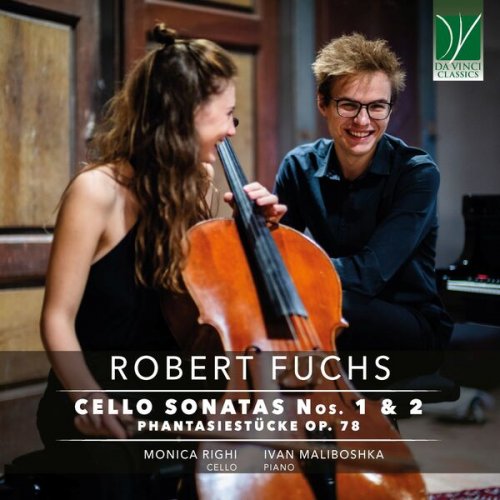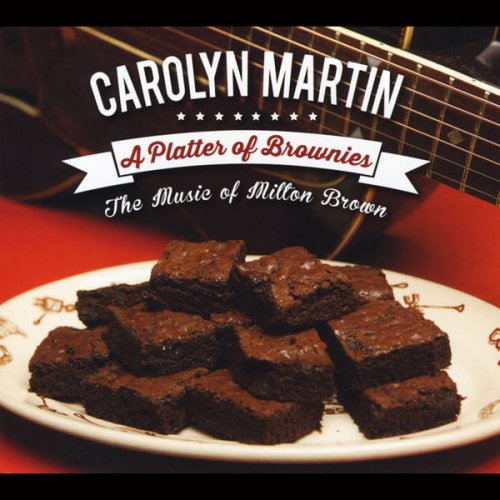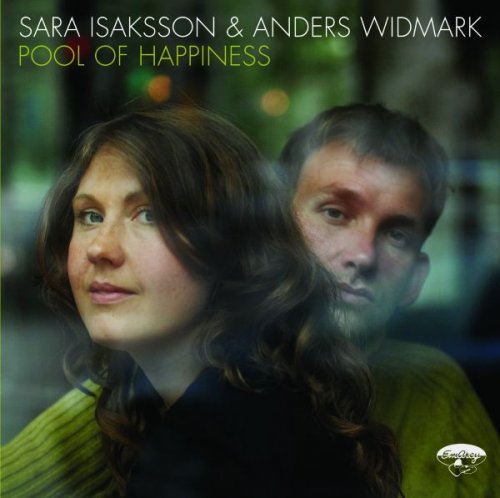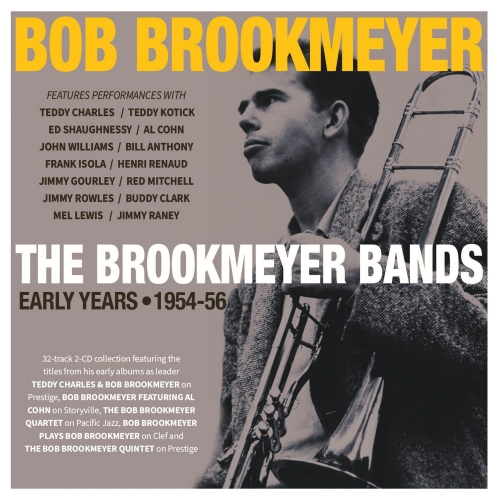Monica Righi, Ivan Maliboshka - Robert fuchs: cello sonatas nos. 1 & 2, phantasiestücke op. 78 (2025)

Artist: Monica Righi, Ivan Maliboshka
Title: Robert fuchs: cello sonatas nos. 1 & 2, phantasiestücke op. 78
Year Of Release: 2025
Label: Da Vinci Classics
Genre: Classical
Quality: flac lossless (tracks)
Total Time: 01:26:41
Total Size: 305 mb
WebSite: Album Preview
TracklistTitle: Robert fuchs: cello sonatas nos. 1 & 2, phantasiestücke op. 78
Year Of Release: 2025
Label: Da Vinci Classics
Genre: Classical
Quality: flac lossless (tracks)
Total Time: 01:26:41
Total Size: 305 mb
WebSite: Album Preview
01. Sonata No.1 in D Minor, Op. 29: I. Molto moderato
02. Sonata No.1 in D Minor, Op. 29: II. Scherzo. Allegro
03. Sonata No.1 in D Minor, Op. 29: III. Adagio
04. Sonata No.1 in D Minor, Op. 29: IV. Allegro non troppo, ma giocoso
05. Sonata No.2 in E-Flat Minor, Op. 83: I. Allegro moderato assai
06. Sonata No.2 in E-Flat Minor, Op. 83: II. Adagio con sentimento
07. Sonata No.2 in E-Flat Minor, Op. 83: III. Allegro vivace
08. Phantasiestücke, Op. 78: No. 1, Etwas bewegt, Launig
09. Phantasiestücke, Op. 78: No. 2, Ruhig und äußerst zart
10. Phantasiestücke, Op. 78: No. 3, Lebhaft
11. Phantasiestücke, Op. 78: No. 4, Ruhig und gesangvoll
12. Phantasiestücke, Op. 78: No. 5, Anmutig bewegt. Menuett
13. Phantasiestücke, Op. 78: No. 6, Etwas langsam, sehr innig
14. Phantasiestücke, Op. 78: No. 7, Lebhaft bewegt
The figure of Robert Fuchs is today largely forgotten, and fully undeservedly so. When he is remembered, he is cited as the brother of another Fuchs, or as the teacher of a plethora of famous students, or as the “Serenaden-Fuchs”, the serenade fox, as he was nicknamed by his contemporaries. While all of these elements are certainly part of his story and personality, they by no means exhaust the complexity and richness of a protagonist of the musical world of his era.
Fuchs came from a numerous and very musical family based in Styria. He was the youngest of thirteen siblings. His father, Patritz, encouraged him in his first musical studies; thsey involved learning to play a number of instruments (flute, violin, piano, and organ) and becoming proficient in thoroughbass. These first steps in the musical world were guided and encouraged by his brother-in-law, Martin Bischof. Robert then explored the possibility of a career as a schoolteacher, studying toward this goal and receiving some practical training in the city of Graz; soon, however, it became clear that his true vocation was music.
He moved to Vienna in 1865, where he studied with Anton Bruckner, Felix Otto Dessoff and Joseph Hellmesberger. During that time, he earned his living as the organist at the church of the Piarists. His student works earned him the appreciation of his teachers, and in particular two of his youthful symphonies were held in high consideration. Dessoff conducted his pupil’s music in a performance with the Philharmonic orchestra in 1872. However, the concert received harsh criticism by Anton Rubinstein, whose vitriolic observations wounded the young composer, discouraging him from writing other large symphonic scores for some time. A work which earned Fuchs unconditional admiration was his first Serenade for strings, to which he would owe the nickname cited above. It became one of the all-time favourites of the Wiener Philharmoniker for nearly sixty years after its premiere. The following Serenades confirmed Fuchs’ talent in this field, and established him firmly as an appreciated composer in this genre.
Probably also thanks to their success, Fuchs was appointed first as a substitute teacher at the Conservatory of Vienna, and soon after as the professor of harmony. He would remain in the Conservatory’s faculty for thirty years, being promoted to the chair of Composition; there, he would cooperate with one of his brothers, Johann Nepomuk, who became the Director of the same institution. The list of his students includes some legendary names, among whom are Gustav Mahler, Hugo Wolf (they both had him as a teacher in his first year in this capacity), Georges Enescu (who was the youngest and the first non-Austrian student ever), Jean Sibelius, Alexander von Zemlinsky, Franz Schmidt (who had chosen to be taught by Bruckner but could not pursue his plan due to Bruckner’s poor health), and Franz Schreker.
In the 1870s, Fuchs developed a close friendship with Johannes Brahms (his senior by 14 years), who held him in high esteem (and this was not the case with most of his other colleagues). Brahms famously wrote: “Fuchs is a splendid musician. Everything is so fine, so clever, so charmingly invented! You always enjoy it”. Brahms’ support of Fuchs was not just expressed in words, but also in deeds: it was Brahms who sponsored his younger colleague with publisher Simrock, who eventually accepted to publish some of his most ambitious orchestral works. Among these was the First Piano Concerto, in B-flat, written in the same key and at the same time as Brahms’ Second Concerto. Indeed, Brahms’ influence began to show in Fuchs’ own style in those years; and the “stain” of being a Brahmsian would be one of the factors preventing Fuchs from gaining, and maintaining, the fame he would have deserved.
Valuable information about the musical and cultural world of Fuchs is provided by a book of memoirs, Erinnerungen an Robert Fuchs, penned by Anton Mayr. He was a close friend of the composer, and we owe to him not only an abundance of anecdotes and facts about Fuchs, but also the very composition of many pieces. Mayr was in fact an amateur player of cello and double bass, who played with Fuchs the main works of the cello repertoire, and who encouraged his friend to compose for the cello (thus were the Phantasiestücke op. 78 and the Second Cello Sonata created).
In the early 1900s, Fuchs and his teaching began to be perceived as outdated at the Conservatory; he was remaining faithful to tonality and to the august Viennese tradition when new styles like Debussy’s or Scriabin’s were being forged. In 1925, Fuchs abandoned his compositional activity, and he would die two years later.
It is ironic that Fuchs did not feel a particular attraction for the cello as an instrument, and therefore he was not really drawn to composing for it. However, all of his works featuring the solo cello received positive endorsement by Mayr himself and by Johannes Brahms.
The First Cello Sonata is the earliest of Fuchs’ three main works for the cello, and it displays a style markedly different from that of the later works. It also mirrors Fuchs’ attentive consideration of the contemporaneous musical scene and of what other composers were creating in those same years. Published in 1881, but written some time earlier, it is dedicated to David Popper. His name is extremely well-known among cellists of both today and yesterday, since his Etudes remain a staple in the education of budding instrumentalists. What we do not know, however, is the circumstance of Popper’s acquaintance with Fuchs. Were they close friends? Or had they met at all? Was Popper involved in the actual shaping of the Sonata, possibly providing some feedback about its compositional features? Or maybe he was just the recipient of an unsolicited dedication?
While these questions are still open, and may remain open forever, undeniably Brahms was very impressed with the work. In Mayr’s words, “Brahms had recommended it to the publisher Simrock as Fuchs’s best and snappiest work, since Gurkhaus-Kistner didn’t want to bite, but after some hesitation, Gurkhaus finally took the sonata over to his publishing house”.
In this work, we are particularly mesmerized by the wide span of the melodies in the first movement. Their ambitious scope and singing quality suggest and encourage comparisons with Bruckner, and they bear witness to the composer’s ability in sustaining long musical discourses. Real tragedy is probably missing from these melodies, but there is a noteworthy pathetic dimension, which provides momentum to the piece’s unfolding. The scherzo is built on a theme which had originated in one of Fuchs’ student works. The slow movement is rather compact in terms of length, but full of expressiveness and intensity in terms of depth. The Finale, an Allegro non troppo ma giocoso, which follows the slow movement without interruptions, is the occasion for the Sonata’s tension to relax and for the piece to find its conclusion in a cheerful and spirited mood, with allusions to the gipsy style of many Central European pieces. Allusions are also copiously found to Beethoven, and in particular to his Sonata op. 69 for cello and piano.
The Phantasiestücke op. 78 were composed in 1905, upon a prompting by Mayr. Although the composer was initially slightly reluctant, the process of composition was swift and smooth, and within a month the collection was completed. The cycle, although intended as such, can also be divided into individual pieces, and in fact four pieces among the collection’s seven works were successfully premiered at the Vienna Conservatory. The composer and Mayr himself played some pieces of this cycles in public, and such was the audience’s approval that they had to repeat the concert within days.
Their title is an explicit allusion to Robert Schumann, who wrote several cycles with this title. Fuchs himself would adopt this label for some other series he composed. Similar to the Schumannesque model, Fuchs’ Fantastic pieces are fascinating and spirited at the same time, sounding as something from another place and era, but also bubbling with sparkling ideas. One device Fuchs employs abundantly here, and which distinguishes his writing here from that of the Sonatas, is the generous use of pizzicato. Furthermore, the scoring sees the cello taking the front of the stage or the role of accompanist very flexibly.
Three years later, the time came for Fuchs’ second and last Cello Sonata. The first idea for it came to Fuchs in 1907, and by the end of 1908 the piece had grown into a fully-fledged Sonata. Mayr writes: “On December 3, 1908, Fuchs reported that he had treacherously, i.e, without having given me a hint beforehand, composed a second cello sonata and that this secrecy gave him a special pleasure”.
The piece’s premiere had to be postponed due to the intended soloist’s tragic and unexpected death. In Mayr’s words, “The second cello sonata…Robert Hausmann…was to play with Ms. [Marie] Baumayer on January 19, 1909, in Vienna. Before that, a quasi-general rehearsal should be held with Hofrat Oser. When Fuchs got there, he saw everything in motion and dismay; Hausmann is seriously ill. Fuchs went to Hausmann’s hotel with Ms. Marie Baumayer and they learned that the cellist was dead after a stroke had killed him. ‘It would have been too nice, it was not meant to be,’ he wrote to me”.
Here, the world of Brahms is clearly at the horizon, and his influence is evidently recognizable in terms of form, melodic structures, rhythm, and piano writing. The slow movement’s form is reminiscent of some clarinet works by Brahms, although Fuchs is careful to maintain the freshness of his own inspiration rather than merely copying Brahms. The Finale is quintessentially Viennese and masterfully built in terms of musical ideas and their development.
Once again, these works bring to light the importance of an unjustly forgotten composer, and invite us to discover the beauty and musical interest of his oeuvre.








![Wadada Leo Smith - Divine Love (1979/2025) [Hi-Res] Wadada Leo Smith - Divine Love (1979/2025) [Hi-Res]](https://www.dibpic.com/uploads/posts/2025-12/1765802240_cover.jpg)